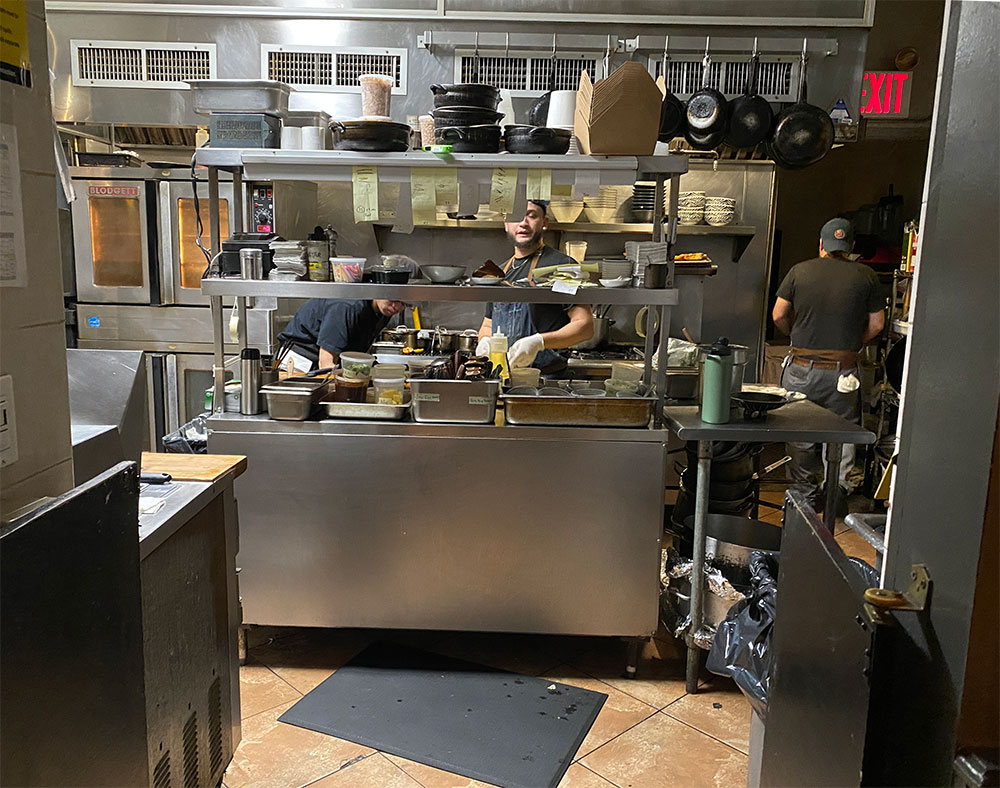Eating At Shalom Japan: They Still Got It
By Ian MacAllen on Monday, November 20th, 2023 at 9:48 am
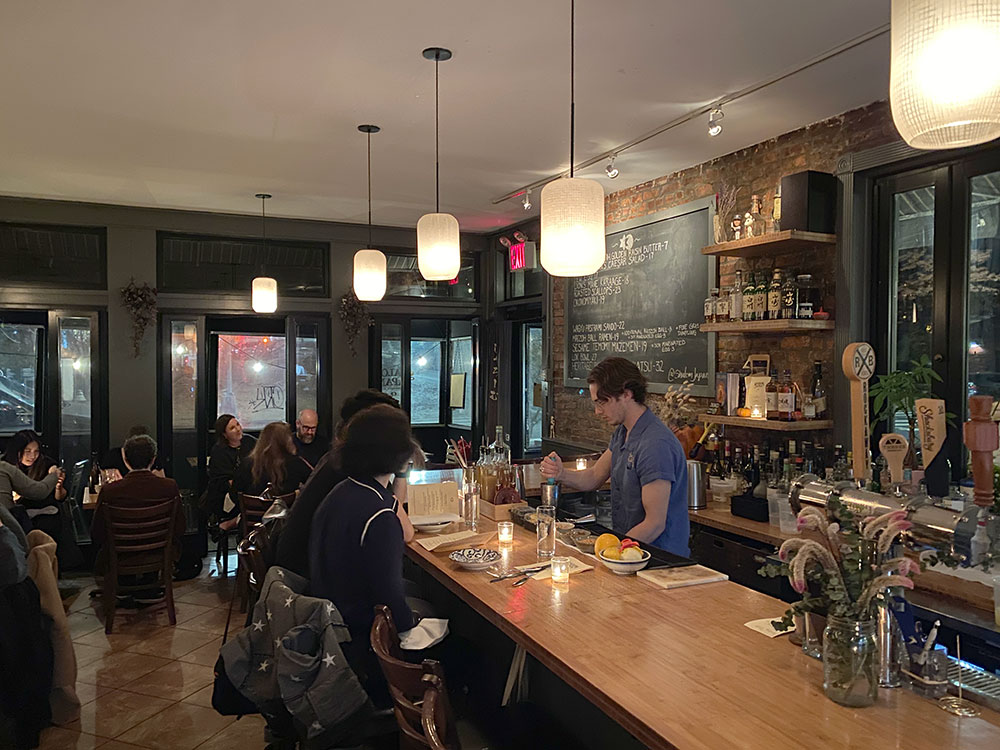
Shalom Japan has been around quite a while, opening back in 2013. The chefs are a married couple, Aaron Israel and Sawako Okochi, and the menu is a collaboration merging their two respective culinary cultures – Jewish and Japanese cuisine. The result, of course, is remarkable. The restaurant remains at hit on tastemaking sites like The Infatuation and they regularly receive the Michelin Bib Gourmand.
The restaurant is located in a sort of isolated area surrounded mainly by residential neighbors. It’s not far from Marcy Avenue or Grand Street or Montrose Avenue, all of which have thriving eating and drinking scenes, but it’s between all of these places. There’s not much chance you’re going to come across this by accident thanks to Robert Moses and the BQE canyon bisecting Williamsburg
I’ve eaten here before, shortly after it opened–to be honest, long enough ago I can’t recall when, but more than five years. I happen to walk by it often since for me it’s in a direct line between my apartment and the waterfront, and every time I find myself thinking that “we should eat there again.” As luck would have it, the baby was having a sleepover with my in-laws this past Friday night, and after missing a chance to book reservations at Bonnie’s, I suggested looking up some old favorites.
We booked a table for three– myself, my brother, and our longtime friend. We were one short for the tasting menu, but three of us could do some damage on the menu anyway. The menu isn’t huge–and that’s fine because what is there has always been–and still was–absolutely terrific.
The table for our reservation was just being cleared when we arrived. The restaurant is small too, with tightly packed tables. The changes in outdoor dining rules allowing their long patio must have been a boon for business, doubling their capacity. On this warm November night, the portent to the coming climate apocalypse we all happily ignored, there were plenty of people eating outside in the covered patio. The city’s reluctance to preserve outdoor dining – or rather, to make it so untenable and difficult, few small restaurants will keep it – is one of many policy failures of the current administration.
Anyway, we ordered a round of drinks from the bar. I ordered a N8-groni, with gin, Cynar 70, and sweet vermouth. It was thoroughly adequate, but otherwise not particularly memorable. The table was ready before the drinks and we were swept to our spot in no time.
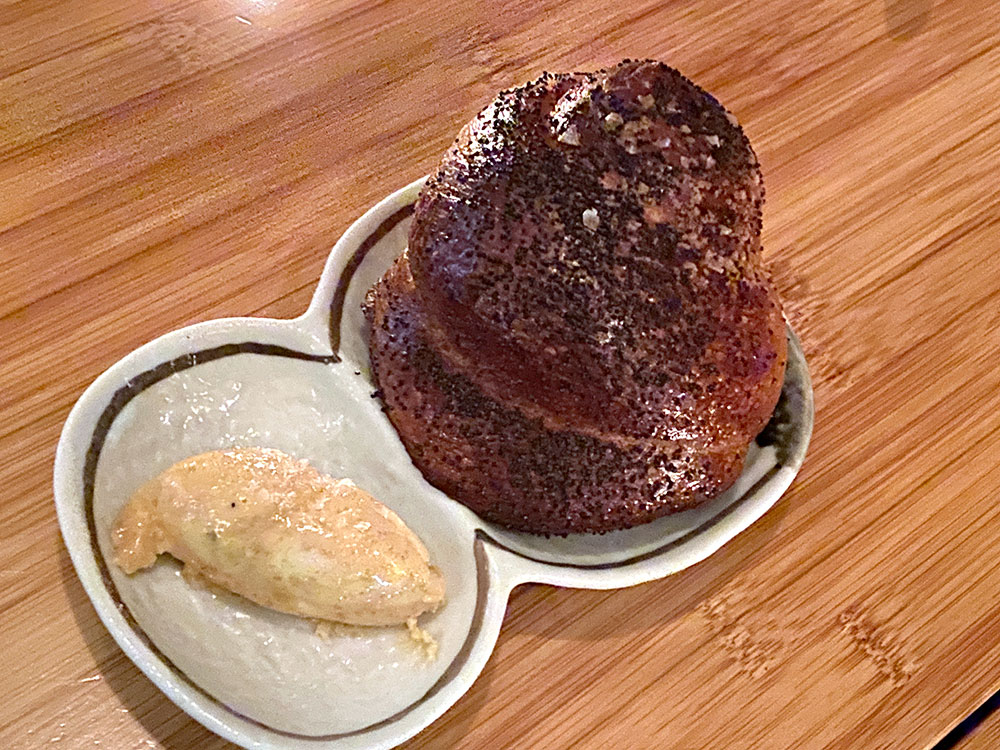
We started out with the Sake Kasu Challah, the equivalent of bread service. It’s an enriched roll with a crispy bottom and salty top. The bread comes out warm and is served with a quenelle of soft, sweetened butter.
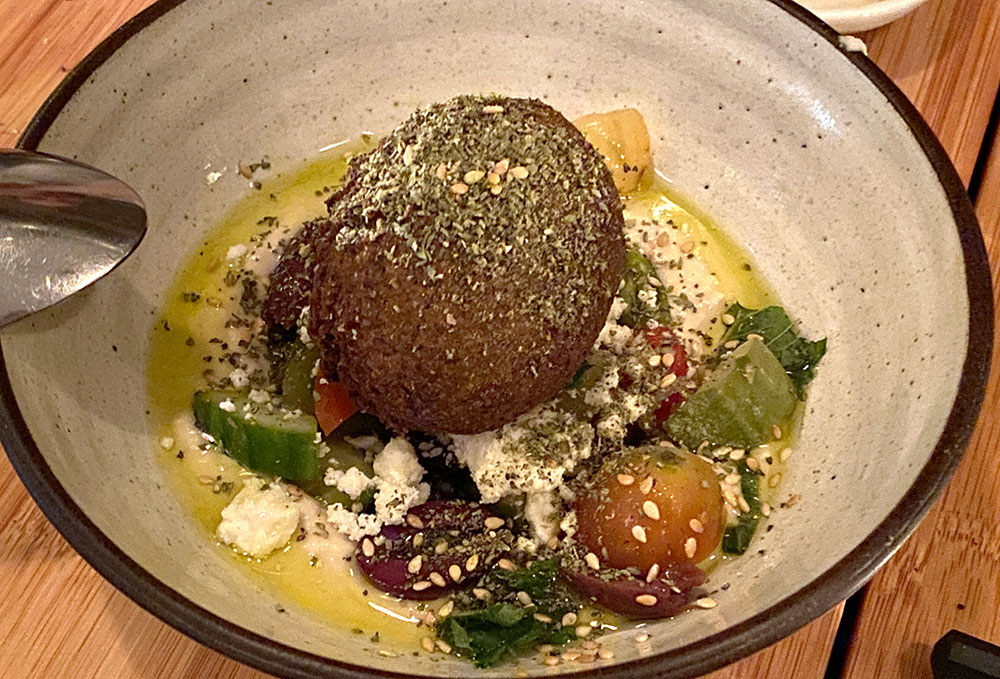
Following the bread, we had the Jew Egg. This dish is reminiscent of a Scotch egg, although there is no meat wrapped around it. It’s fried, with a crispy breadcrumb shell, and comes sitting in hummus with classic Mediterranean flavors.
The jammy yolk is exactly what you want. The execution of the food is admirable here–nobody in that kitchen is resting on a decade of reputation. They deliver. Yolks are hard to cook, and hard to perfect on every serving, but here it was, golden yellow and soft just like it should be.
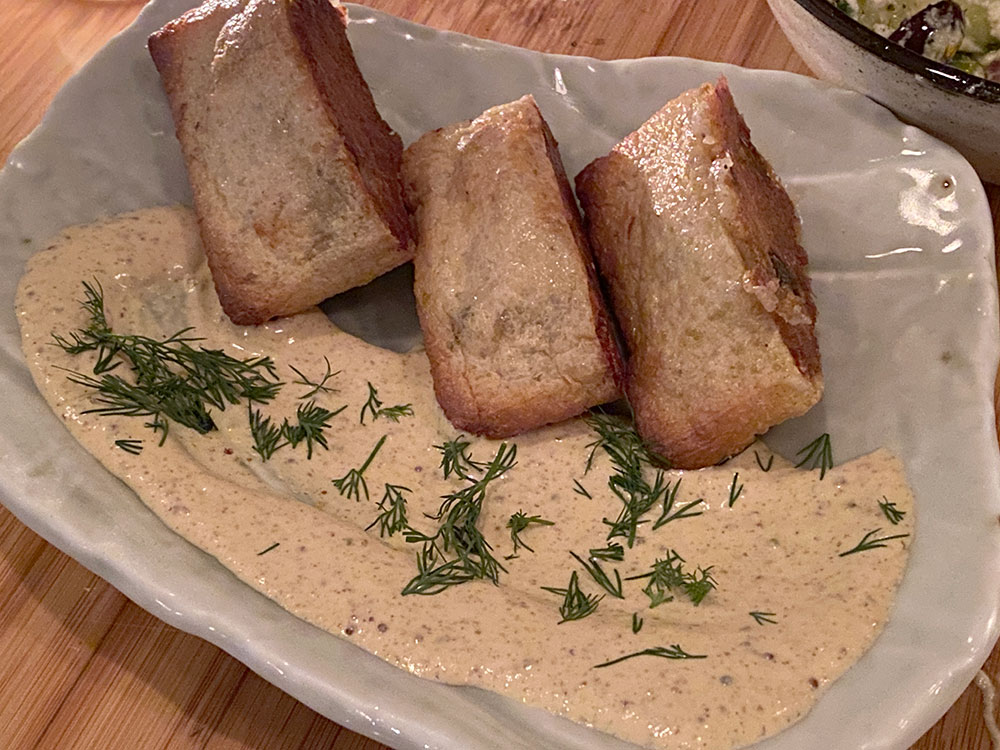
Among the specials that night was a “hot pocket.” We decided these were incorrectly named because they were clearly the baby of a Japanese gyoza and a New York Knish. This was the one dish I thought missed the mark. A hot pocket is supposed to be hot, greasy, and gooey, and maybe burn your mouth. It didn’t do any of this and was far more one-note than I hoped. A Knish on the other hand, is allowed to be more of a singular tune and I suspect my expectation would have been adequately tempered with a better naming convention. As a knish, it was delicious.
The pacing of the meal was quite good–these first dishes were doled out with enough time to enjoy them. We were not being rushed out the door as apparently happens elsewhere these days, and the dishes arrived at the table at a leisurely pace. We noshed comfortably, chatting and drinking the way one is meant to enjoy a restaurant.
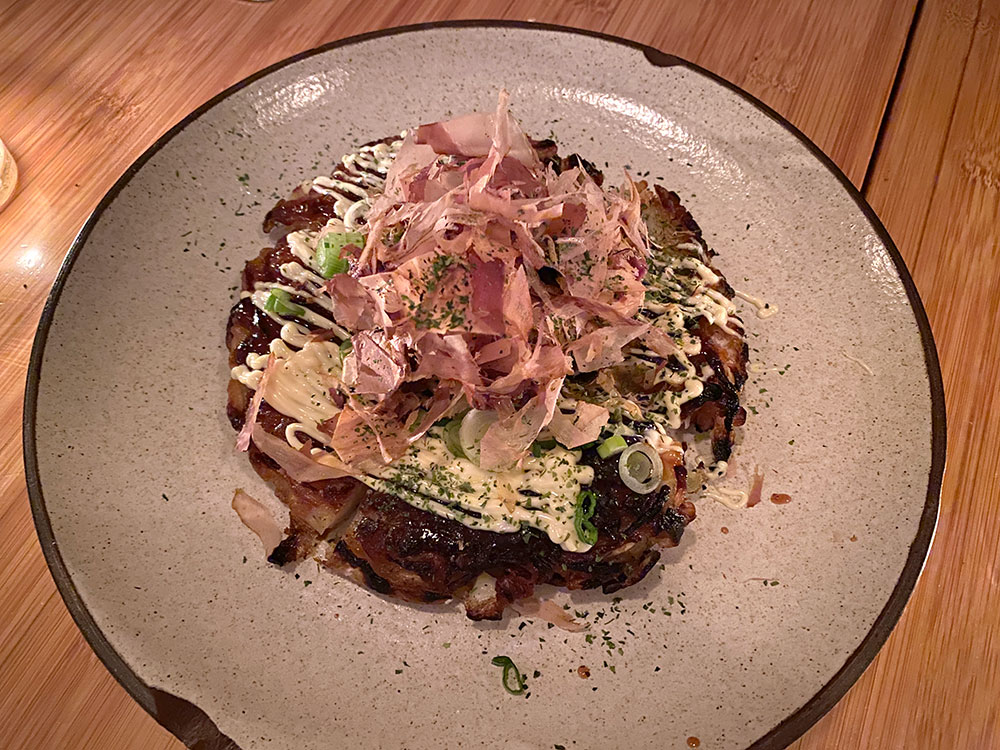
The pastrami Okonomiyaki was absolutely spectacular though. In Osaka, a traditional Okonomiyaki is a savory pancake holding a protein like calamari or octopus and topped with dried bonito flakes. I don’t personally love bonito flakes, although they’ve become a popular condiment in recent years. Emmy Squared, another nearby restaurant, serves French fries topped with the flakes, and they’ve appeared in more places than I prefer.
However, Shalom Japan makes it work. The pastrami is fatty, and that’s enough to cut the smokiness of the bonito flakes, and the flavor compliments the pastrami well. I enjoyed it more than I expected.
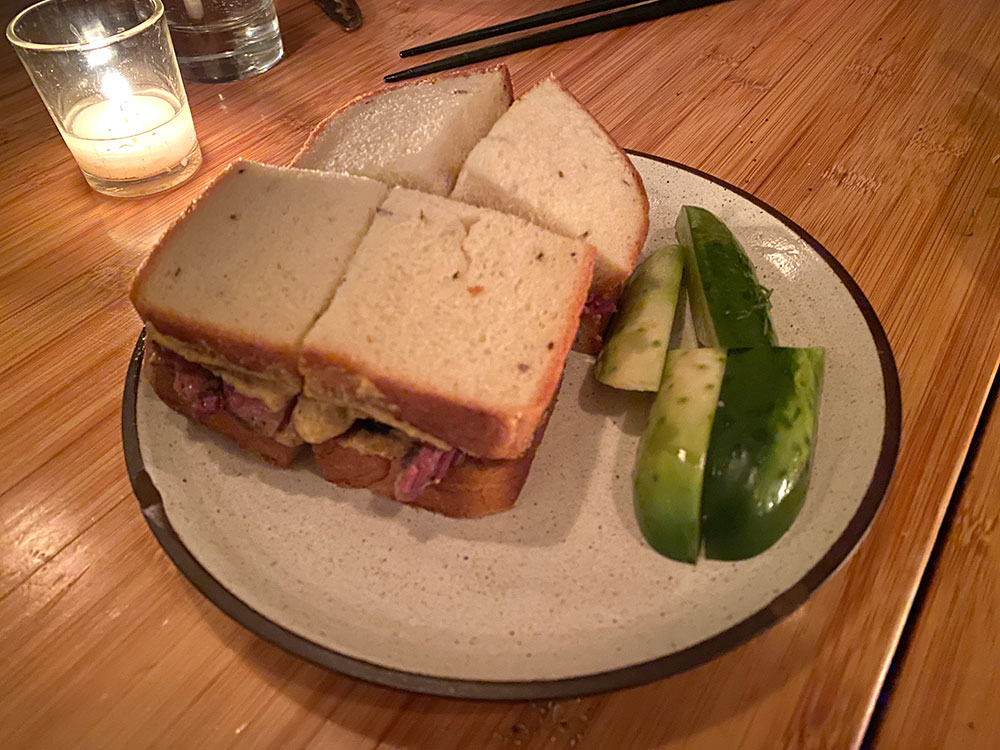
We finally arrived at the large plate portion of the meal with the Wagyu Pastrami Sando. The sandwich is in its basic form a pastrami on rye. The execution is spot on. The sandwich arrived cut four ways with soft rye bread. The pickles were sharp and fresh, cutting the heaviness of the fatty pastrami. Honestly though, can you ever have enough pastrami?
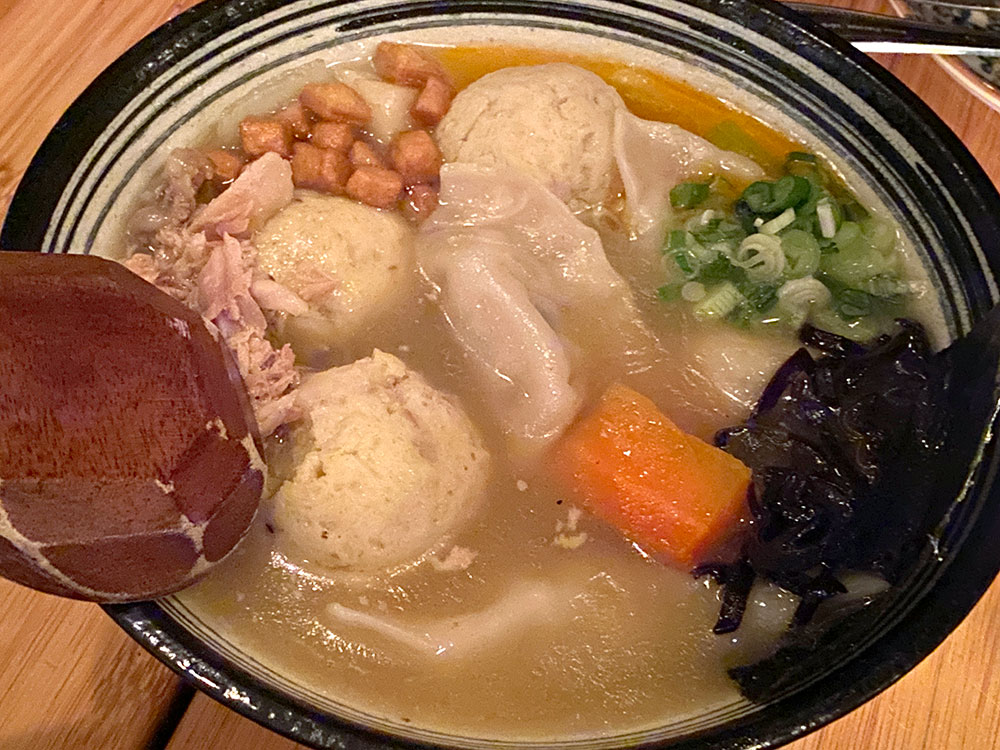
The Matzoh Ball Ramen was a dish I insisted on having. It actually split well among three people, even though we added extra matzoh balls so we each had one, plus foie gras dumpling for each of us as well. We insisted on getting a foie gras dumpling each while we still can–
If you haven’t been following, New York City passed a foie gras ban back in 2019, set to take effect three years later. Four years on, the law is currently in the courts, and restaurants are still free to serve the delicacy.
I spent the weeks following the passage of the ban eating as much foie gras as I could. (One of my favorite preparations is just a few blocks from Shalom Japan, at Traif, which was another restaurant we considered for the evening). Of course, a few months later, COVID shut down the restaurants in the city along with my attempts to eat foie gras at the 1,000 or so restaurants serving it.
Since foie gras is a high value menu item, it is good for restaurants’ and servers’ bottom line. And, as it turns out, it’s hugely important to New York State agriculture. Most of the foie gras produced in America comes from the Hudson Valley, with New York City eating a large portion of it.
The city’s ban would effectively make production untenable, and disrupt supplies around the country. That’s bad for farmers upstate who rely on the high value item to balance their books, and bad for the farm workers who end up getting paid pretty well.
Animal rights activists target foie gras because it’s seen in the United States as a niche product (but not in civilized countries like France, where by the way, the death penalty has been banned since 1981). Meanwhile, banning beef feedlots and factory-farmed pigs and chickens would do a lot more for animal welfare, but I don’t imagine the New York City council having the chutzpah to ban hamburgers any time soon.
Foie gras is the perfect addition to the menu at Shalom Japan, since it is a traditionally Jewish dish, and gyoza are typically filled with the very unkosher pork. The technique for producing foie gras was developed in the Roman era, and spread across Europe by Jewish communities. It served as a substitute for luxury products that were traif – that is, not kosher. So another way of looking at foie gras bans is an antisemitic attack on Jewish culture.
Luckily for everyone, the state of New York has a vested interest in not seeing the entire agricultural economy of the Hudson Valley gutted by a few determined vegans and blocked the ban. The case is currently working through the court system.
The foie gras dumplings were a lovely addition to the ramen. I savored every bite, nibbling at them to prolong the taste.
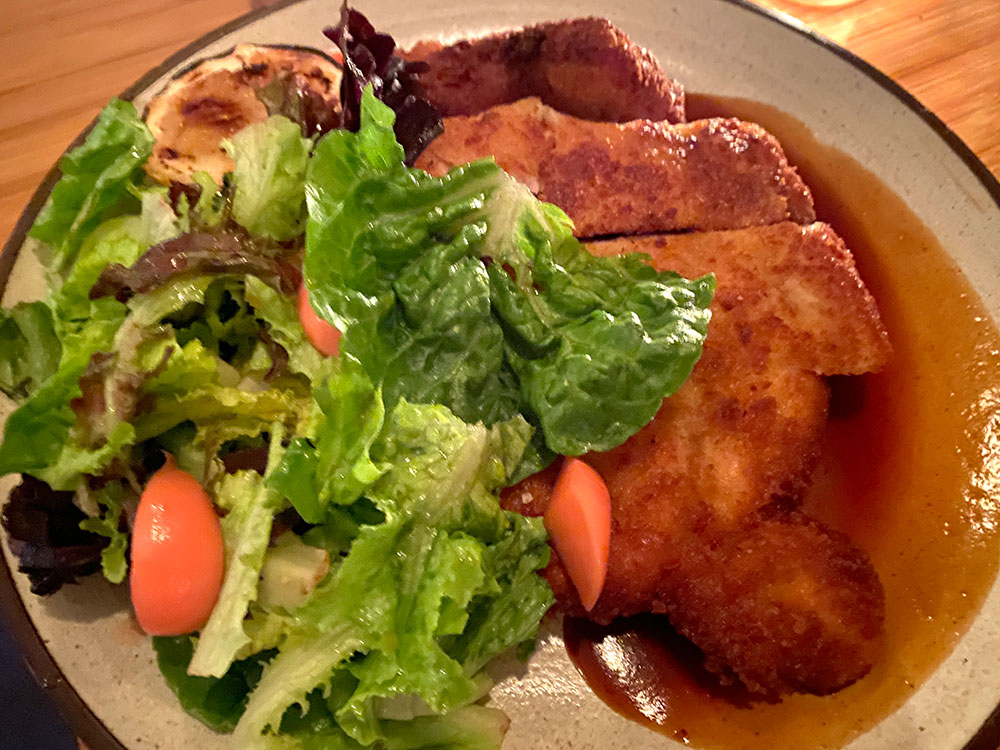
Our final dish of the night was the Heritage Pork Chop Tonkatsu. The piece of meat was enormous, and a well executed dish. The salad on the side had acid from the yuzu dressing which is always appreciated with a fried piece of meat, but overall was the least interesting component of the night.
We decided to skip any dessert, but altogether were quite satisfied. It’s been ten years since the restaurant opened, but it still delivers. Longevity is hard to find in restaurants, but I see why Shalom Japan is going strong. There are newer restaurants chasing the shining star of novelty, but don’t overlook Shalom Japan.
The team behind Shalom Japan also has a cookbook with 80 recipes, Love Japan, that includes a mix of classic Japanese recipes and items from the menu.
